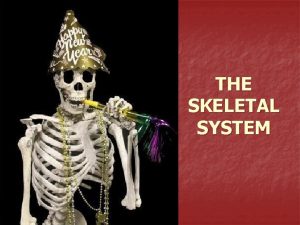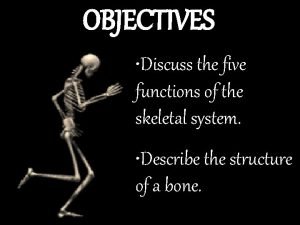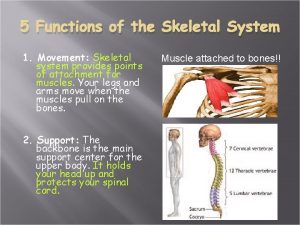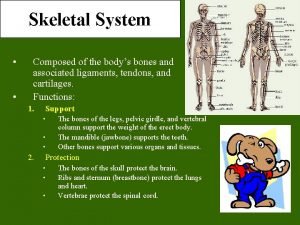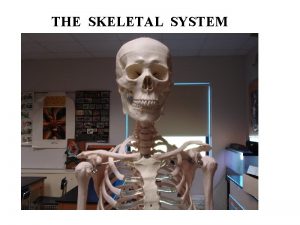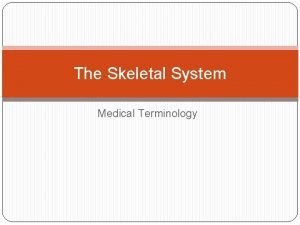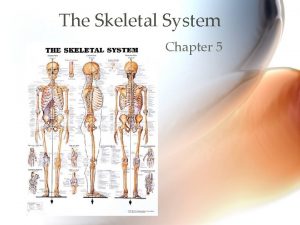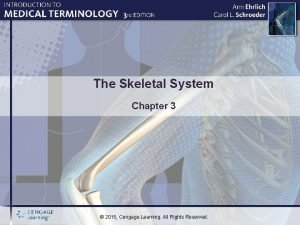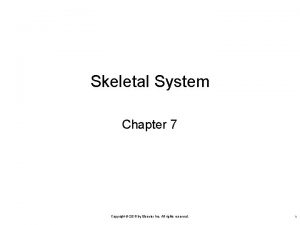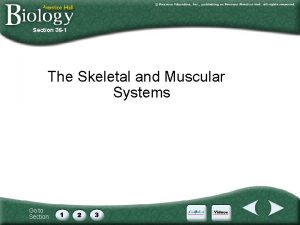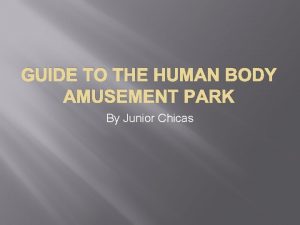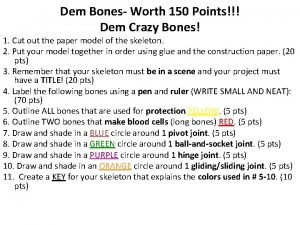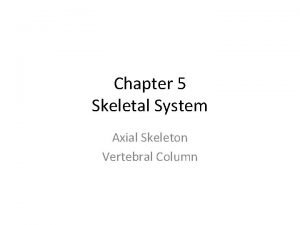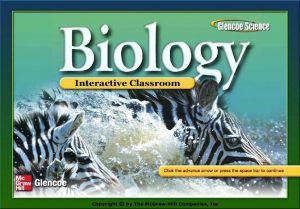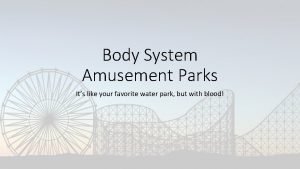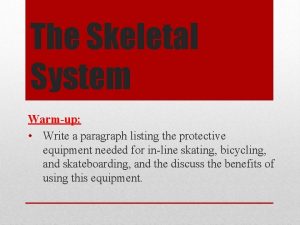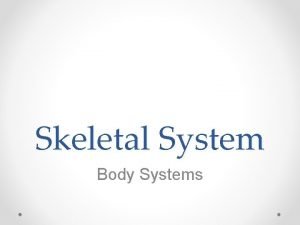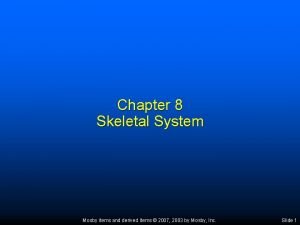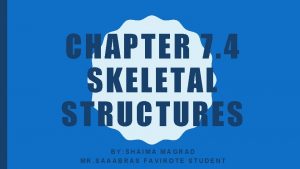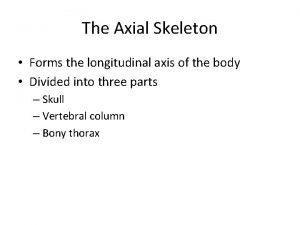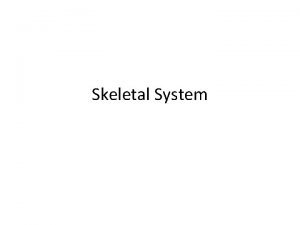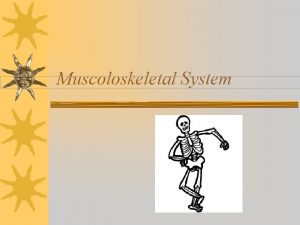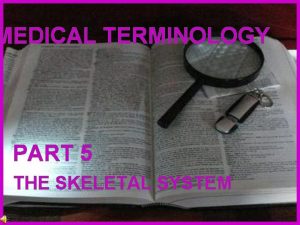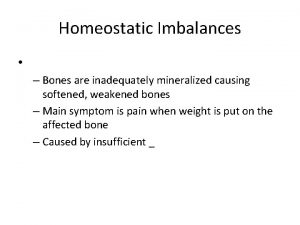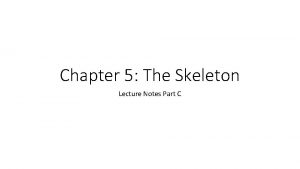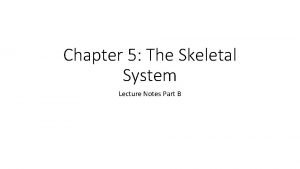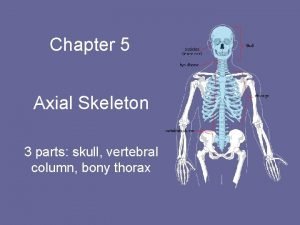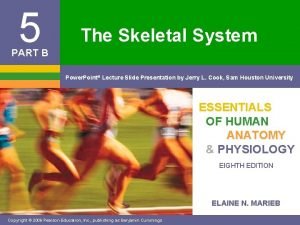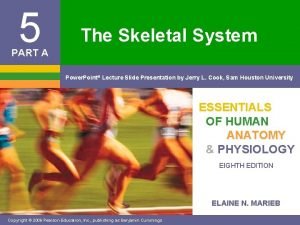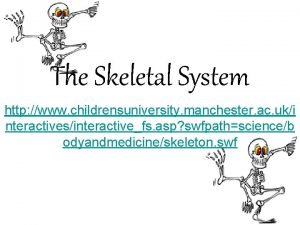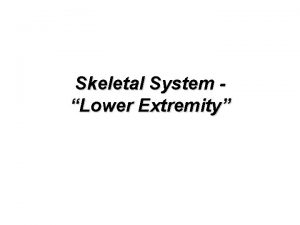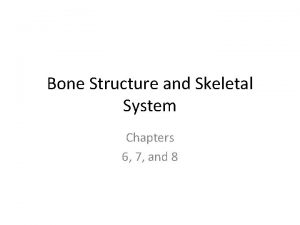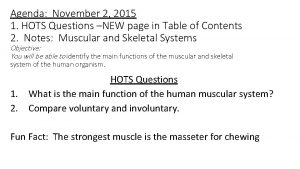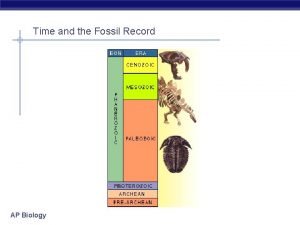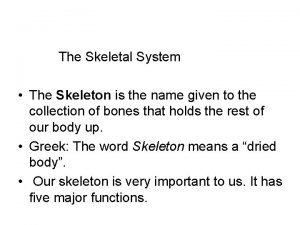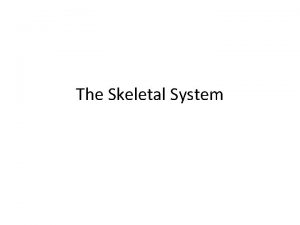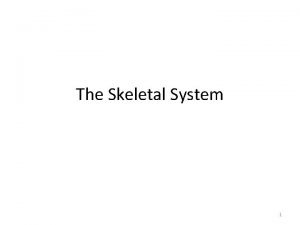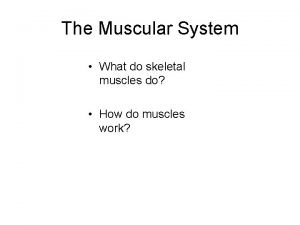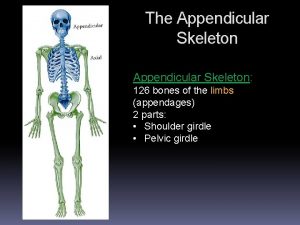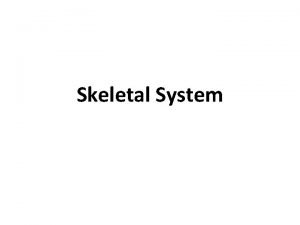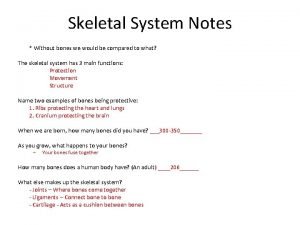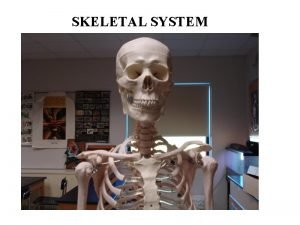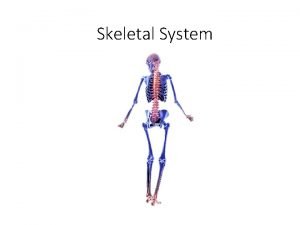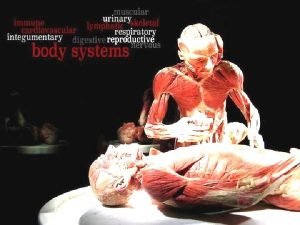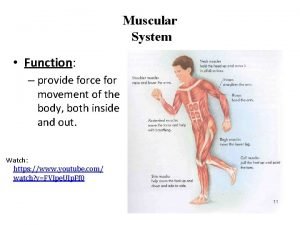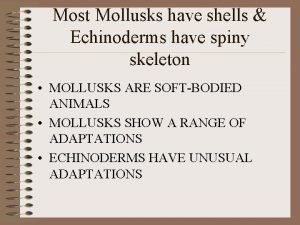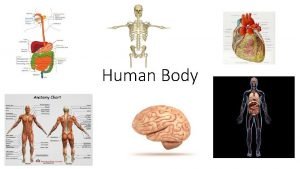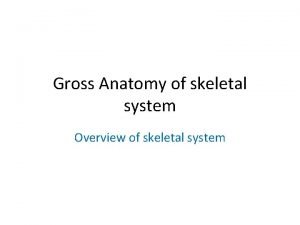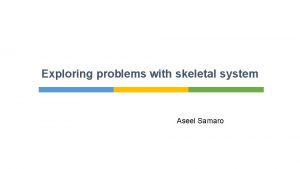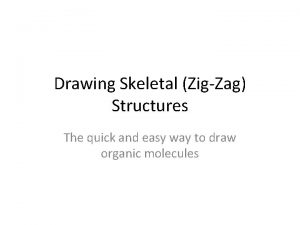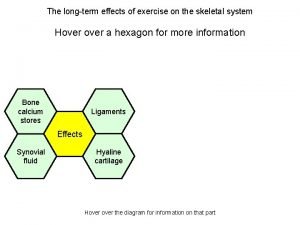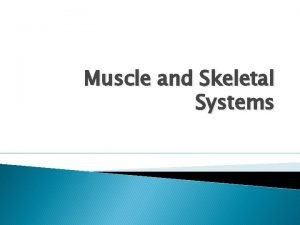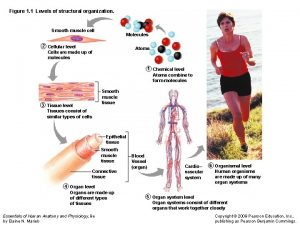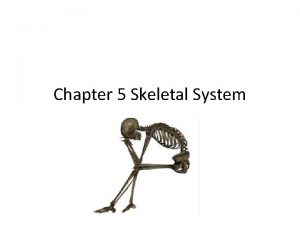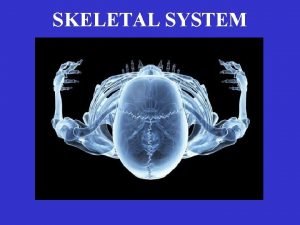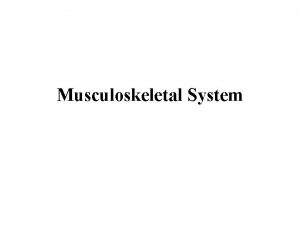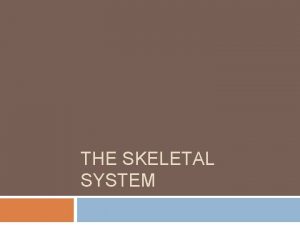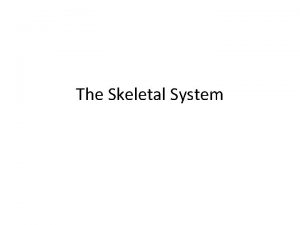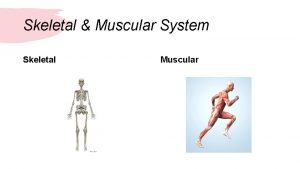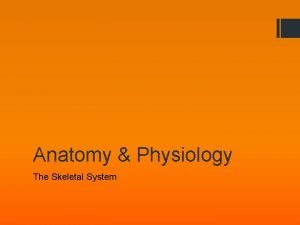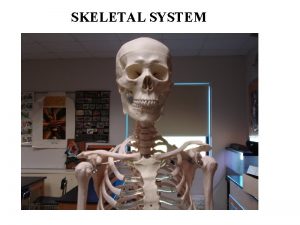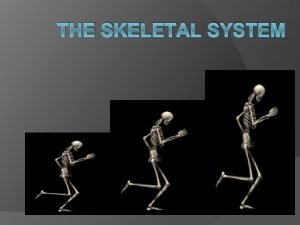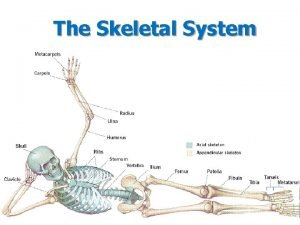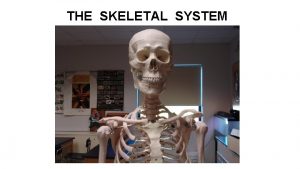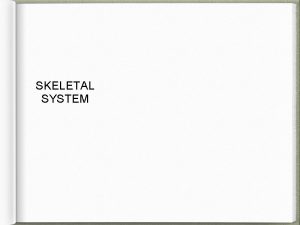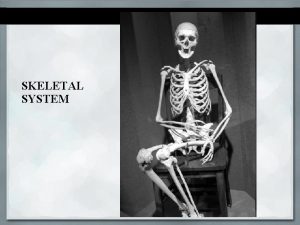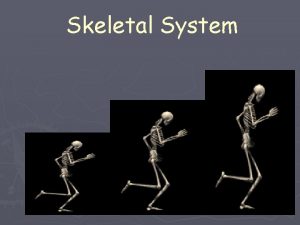THE SKELETAL SYSTEM Functions of the Skeletal System











































































- Slides: 75

THE SKELETAL SYSTEM

Functions of the Skeletal System Support and protection Body movement Blood cell formation = hemopoiesis (occurs in bone marrow) Storage of inorganic materials (salt, calcium, potassium…. )

ORGANIZATION About 206 bones 2 Main Divisions

Axial Skeleton ●Head, neck, trunk ●Skull ●Hyoid Bone ●Vertebral Column ●Thoracic Cage (ribs, 12 pairs) ●Sternum

Hyoid Bone

Appendicular Skeleton Limbs & Bones that connect to the Pectoral Girdle (scapula, clavicle, arms) Pelvic Girdle (coxal bones, legs)

BONE STRUCTURE - Long Bone 1. Epiphysis (end) 2. Diaphysis (shaft) 3. Articular Cartilage (hyaline cartilage, padding) 4. Periosteum (membrane that covers entire bone)

Inside the Long Bone 5. Medullary Cavity – hollow chamber filled with bone marrow Red Marrow (blood) Yellow Marrow (fat) Endosteum – lining of the medullary

Types of Bone Tissue Compact (wall of the diaphysis) Spongy (cancellous, epiphysis) - red marrow


* Assignment – Coloring of a Long Bone

Review the Structure of a Long Bone Matching quiz at http: //www. mhhe. com/biosci/a p/holehaap/student/olc 2/chap 07 matching 01. html

Microscopic Structure Bone tissue is called OSSEOUS tissue - the matrix is composed of collagen and inorganic salts OSTEOCYTES - mature bone cells, enclosed in tiny chambers called LACUNAE - these form rings called lamella around a HAVERSIAN CANAL which houses blood vessels CANALICULI - tiny canals that link osteocytes Haversian and Volkmann canals provide passageways for blood vessels

Osteocytes Volkmann’s Canal Haversian Canal



Test Yourself Find the. . . Haversian Canal Volkman's Canal Lamellae Spongy Bone Compact Bone


BONE DEVELOPMENT & GROWTH 1. Intramembranous bones – flat, skull 2. Endochondral bones – all other Bones first form as hyaline cartilage. The cartilage then gradually changes into bone tissue - a process called OSSIFICATION PRIMARY OSSIFICATION CENTER (shaft) SECONDARY OSSIFICATION CENTER (ends)

Bone Development & Growth EPIPHYSEAL DISK (growth plate) is a band of cartilage between the epiphysis and diaphysis These areas increase bone length as the cells ossify

OSTEOBLASTS produce cells called osteocytes.

RESORPTION OSTEOCLASTS - dissolve bone tissue to release minerals, process is called RESORPTION


Bone Growth

Bone Growth * Assignment - Coloring of the Aging Hand


Types of Joints (articulations) Synarthrotic (not moveable, aka sutures) *skull Amphiarthrotic (slightly movable) *vertebrae Diarthrotic (moveable joint ) *knees, elbows, wrist, shoulder. . etc *synovial fluid for lubrication

Types of Synovial Joints 1. Ball and Socket (shoulder / hip) 2. Hinge (elbow, knee) 3. Pivot (lower arm) 4. Saddle (thumb)

BONES OF THE SKULL 1. Frontal 2. Parietal - 3. Temporal 4. Occipital - 5. Sphenoid - 6. Ethmoid - 7. Maxilla - 8. Mandible - 9. Zygomatic - 7 9 8

Sphenoid Bone Names for its shape - a butterfly!

Sutures - connection points 1. Coronal - between frontal and parietal bones 2. Lambdoidal - between occipital and parietal bones 3. Squamosal - between temporal and parietal bones 4. Sagittal - between parietal bones Sagittal

Suture - refers to any connection between large bones (in fetal skulls, these are called fontanels) Fissure - any wide gap between bones

Fontanels are “soft spots” on an infant’s skull

TOPOGRAPHY OF THE SKULL Foramen - refers to any opening in the skull, nerves and blood vessels leave this opening to supply the face Foramen Magnum Mental Foramen

Foramen Magnum * Assignment: Skull Labeling

Coronal Suture Frontal Parietal Nasal Sphenoid Temporal Lacrimal Zygomatic Vomer Mandible Maxilla

Coronal Suture Parietal Frontal Squamous Suture Nasal Sphenoid Lambdoid Suture Occipital Maxilla Temporal Mastoid Process Mandible Zygomatic


1. Coronal Suture 2. Frontal 3. Parietal 4. Nasal 5. Squamosal Suture 6. Ethmoid 7. Lacrimal 8. Sphenoid 9. Lamdoidal Suture 10. Occipital 11. Temporal 12. Zygomatic 13. Maxilla 14. Mandible

Coronal Suture Frontal Parietal Sagittal Suture Lambdoid Suture

The Rest of the Bones

Vertebral Column Cervical (C 1 -C 7) Thoracic (T 1 -T 12) Lumbar (L 1 -L 5) Sacrum and Coccyx

Thoracic Cage → 12 pairs of ribs True Ribs = First seven False Ribs = Next 3 pairs Floating Ribs = Last two pairs

Pectoral Girdle HUMERUS (arm) SCAPULAS (shoulderblade CLAVICLES (collarbones)

Bones of the Arm Ulna goes to pinky (P-U) Radius goes to thumb HUMERUS ULNA RADIUS

Wrist Bones Wrist - 8 small bones called carpals Metacarpals (hand) Fingers: Phalanges

Name the carpals for *extra credit on test.

How to learn the carpals? Some Lemurs Try Peanuts That They Can’t Handle

ANSWERS. . . a. Scaphoid b. Lunate c. Triquetrum d. Pisiform e. Trapezium f. Trapezoid g. Capitate h. Hamate

Pelvic Girdle two large COXAL BONES

Pelvic Girdle COXAL The SACRUM is between coxal bones, COCCYX is the tailbone

Bones of the Leg Upper Leg - FEMUR Kneecap - PATELLA Lower Leg - TIBIA & FIBULA

Bones of the Ankle and Upper foot - 7 bones called Tarsals Large heel bone is the calcaneous Foot = metatarsals Toes = phalanges

Assignment – Foot Coloring

Assignment – Skeleton Labeling



Broken Bones


Warning: Next slide is graphic!


Bone Disorders 1. BONE SPURS, also known as osteophytes, occur when the body grows small projections on the edges of bones

2. Plantar fasciitis - common cause of heel pain. -inflammation of the plantar fascia - walking can be painful Graphic Video of Plantar Fasciitis Surgery

3. OSTEOPOROSIS: Increased activity of osteoclasts cause a break down bone, bones become more fragile The spongy bone especially becomes more porous.

Causes of Osteoporosis: 1. Lack of exercise 2. Poor diet 3. Genetics 4. Ethnicity 5. Gender

Why do older people break their hips? A femoral neck fracture is common among older adults and can be related to osteoporosis. This type of fracture may cause a complication because the break usually cuts off the blood supply to the head of the femur.

4. Rheumatoid arthritis is an autoimmune disease which causes joint stiffness and bone deformity Source: http: //www. thetimes. co. uk/tto/public/article 3233439. ece

5. Rickets This preventable bone disease affects young children and is caused by a deficiency of the nutrient vitamin D. Rickets causes weak, brittle bones that fracture easily and bone and muscle pain.

6. ABNORMALITIES OF THE SPINE a)KYPHOSIS is a hunchback curve b)LORDOSIS is a swayback in the lower region.

c) ANKYLOSIS is severe arthritis in the spine and the vertebrae fuse.

d) SCOLIOSIS

7. Fibrodysplasia ossificans progressiva (FOP) → soft tissue regrows as bone. Sufferers are slowly imprisoned by their own skeletons. Munchmeyer disease" or "stone man syndrome"

8. Osteosarcoma Most common bone cancer, primarily affecting the long bones, particularly those in the knee, hip, or shoulder regions. Most commonly affects teenagers and young adults.

FUN FACTS ABOUT BONES Bone is made of the same type of minerals as limestone. ●Babies are born with 300 bones, but by adulthood we have only 206 in our bodies. ●The giraffe has the same number of bones in its neck as a human: seven in total. ●The long horned ram can take a head butt at 25 mph. The human skull will fracture at 5 mph.

 5 main functions of the skeleton
5 main functions of the skeleton What are the five functions of the skeletal system?
What are the five functions of the skeletal system? 5 functions of skeletal muscle
5 functions of skeletal muscle 5 functions of skeletal system
5 functions of skeletal system 5 functions of skeletal system
5 functions of skeletal system Functions of the skeletal system
Functions of the skeletal system Function of muscular tissue
Function of muscular tissue Medical terminology skeletal system
Medical terminology skeletal system Skeletal system
Skeletal system Chapter three skeletal system
Chapter three skeletal system Chapter 7 skeletal system
Chapter 7 skeletal system Chapter 5 the skeletal system figure 5-13
Chapter 5 the skeletal system figure 5-13 Section 36-1 the skeletal system
Section 36-1 the skeletal system Skeletal system amusement park
Skeletal system amusement park Dem crazy bones skeleton template
Dem crazy bones skeleton template Chapter 6 the skeletal system answer key
Chapter 6 the skeletal system answer key Site:slidetodoc.com
Site:slidetodoc.com Chapter 32 section 2 the skeletal system answer key
Chapter 32 section 2 the skeletal system answer key Body system amusement park names
Body system amusement park names Navigating the body movements of the body #1
Navigating the body movements of the body #1 How to care for the skeletal system
How to care for the skeletal system Whats the main function of the skeletal system
Whats the main function of the skeletal system Chapter 8 skeletal system
Chapter 8 skeletal system 7:4 skeletal system
7:4 skeletal system Axial skeleton skull chapter 5
Axial skeleton skull chapter 5 Skeletal system
Skeletal system The axial skeleton forms the longitudinal axis of the body
The axial skeleton forms the longitudinal axis of the body Skeletal system bell ringer
Skeletal system bell ringer Appendicular vs axial skeleton
Appendicular vs axial skeleton Muscolo skeletal system
Muscolo skeletal system Skeletal word for burs
Skeletal word for burs Homeostatic imbalances of the skeletal system
Homeostatic imbalances of the skeletal system Chapter 5 the skeletal system figure 5-13
Chapter 5 the skeletal system figure 5-13 Chapter 5 the skeletal system figure 5-10
Chapter 5 the skeletal system figure 5-10 Chapter 5 the skeletal system
Chapter 5 the skeletal system Chapter 5 the skeletal system axial skeleton skull
Chapter 5 the skeletal system axial skeleton skull Chapter 3 the skeletal system labeling exercises
Chapter 3 the skeletal system labeling exercises Chapter 5 the skeletal system figure 5-10
Chapter 5 the skeletal system figure 5-10 Chapter 5 the skeletal system figure 5-10
Chapter 5 the skeletal system figure 5-10 The childrens university of manchester
The childrens university of manchester Lower extremity appendicular skeleton
Lower extremity appendicular skeleton Skeletal system
Skeletal system Autonomic nervous system muscles
Autonomic nervous system muscles Chapter 8 skeletal system
Chapter 8 skeletal system Learning objectives of skeletal system
Learning objectives of skeletal system Sutural bones function
Sutural bones function Hots questions on skeletal system
Hots questions on skeletal system Skeletal system
Skeletal system Skeletal system
Skeletal system Skeletal system
Skeletal system Introduction of skeletal system
Introduction of skeletal system Proximal epiphysis
Proximal epiphysis Skeletal and muscular system
Skeletal and muscular system What are parts of the appendicular skeleton
What are parts of the appendicular skeleton Skeletal system
Skeletal system Without bones we would be
Without bones we would be Skull labeled
Skull labeled Skeletal system
Skeletal system Digestive system foldable
Digestive system foldable Skeletal system
Skeletal system Mollusca skeletal system
Mollusca skeletal system How much does the skeletal system weigh
How much does the skeletal system weigh Sally left the party to take cathy home
Sally left the party to take cathy home Skeletal system
Skeletal system Zigzag rule drawing
Zigzag rule drawing Long term effects of exercise on skeletal system
Long term effects of exercise on skeletal system Malfunctions of the skeletal system
Malfunctions of the skeletal system Figure of skeletal system
Figure of skeletal system Anatomy and physiology chapter 8 skeletal system
Anatomy and physiology chapter 8 skeletal system All about bones
All about bones Skeletal and muscular system
Skeletal and muscular system Absolute value functions as piecewise functions
Absolute value functions as piecewise functions How to solve evaluating functions
How to solve evaluating functions Evaluating functions and operations on functions
Evaluating functions and operations on functions Hát kết hợp bộ gõ cơ thể
Hát kết hợp bộ gõ cơ thể Slidetodoc
Slidetodoc
